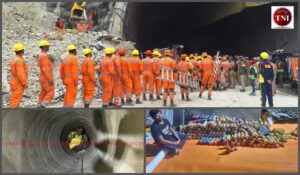The Great Uttarkashi Tunnel Rescue – Big Win for Indian Resilience
The 17-day-long Uttarkashi Tunnel Rescue showcases the strength of international collaboration, government synergy, and human resilience.
Uttarakhand (Uttarkashi) TNI E-DESK: In an unprecedented display of solidarity, empathy, and resilience, a 17-day-long rescue operation successfully concluded on the night of Tuesday, November 28, as 41 workers trapped in the debris of Uttarkashi’s Silkyara Tunnel were safely pulled out. The collapse of the Silkyara-Barkot tunnel, part of the ambitious Char Dham Pariyojana in Uttarakhand, triggered a massive response from various government agencies, the armed forces, and experts from around the world.
The rescue operation involved a remarkable collaboration of seven government agencies, including the Prime Minister’s Office, ONGC, and the National Disaster Management Authority, as well as assistance from the armed forces. Notably, five people from the Prime Minister’s Office dedicated themselves to the operation day and night for 15 days, residing on-site in a container. The Chief Minister of Uttarakhand, General VK Singh, Nitin Gadkari, and other ministers were actively involved, with frequent visits to review the rescue work.
International support played a crucial role, with a special aircraft from Hyderabad transporting an agar machine from Slovenia. The world’s leading rescue expert was brought in by a special plane, and a unique plasma cutter was ordered, traversing continents from Hyderabad to America to ensure its prompt arrival.
Switzerland contributed four machines, robots, and ground-penetrating radar via special aircraft. A helipad and a working runway were constructed at the accident site, along with the installation of a vertical oxygen generator plant. The scale and speed of this rescue operation have left many reflecting on its historical significance, prompting a collective recognition of Indian resilience and the efficacy of an all-of-government approach.
The collapse of the Silkyara-Barkot tunnel, a crucial part of the Char Dham Project, sheds light on larger structural issues. The ambitious project, involving extensive construction in the ecologically fragile Himalayan region, necessitates a reevaluation of development practices. Questions about sustainability and environmental clearances come to the forefront, urging a more thoughtful and creative design for development in the region.
Support Independent Journalism? Keep us live.
The successful use of “rat-hole mining” in the final stretch of the rescue operation highlights the ingenuity and adaptability of the rescue teams. Rat-hole mining, typically outlawed due to its inherent risks, involves extracting coal by digging small pits. In this case, miners with expertise in navigating tight spaces played a pivotal role in the delicate operation, surpassing the limitations of the machinery used earlier in the mission.
https://x.com/TNITweet/status/1729521470890774681?s=20
Rat-hole mining, known for its dangers, especially for those with a child-like physique, has faced bans in the past. The National Green Tribunal (NGT) banned rat-hole mining in Meghalaya in 2014, emphasizing the risks of flooding during the rainy season, lack of proper ventilation, and inadequate protective gear for miners. Despite these bans, the practice persisted due to enforcement challenges.
The Great Uttarkashi Tunnel Rescue not only underscores the resilience of the Indian spirit but also brings attention to the often-overlooked challenges faced by migrant workers. From their plight during the pandemic-induced lockdown to their heroic stories of survival and rescue, there is a compelling need for an all-of-government approach to address the broader issues affecting this vulnerable population.
As the nation celebrates the success of the Uttarkashi Tunnel Rescue, it serves as a blueprint for future natural disasters and accidents. The lessons learned from this operation can guide the development of more effective and efficient response strategies, emphasizing the importance of preparedness, international collaboration, and the resilience embedded in the Indian ethos.



Comments are closed.